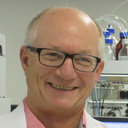Biologically active dibenzofurans from Pilidiostigma glabrum, an endemic Australian Myrtaceae.
Parole chiave
Astratto
In an effort to identify new anti-inflammatory and antibacterial agents with potential application in wound healing, five new dibenzofurans, 1,3,7,9-tetrahydroxy-2,8-dimethyl-4,6-di(2-methylbutanoyl)dibenzofuran (1), 1,3,7,9-tetrahydroxy-2,8-dimethyl-4-(2-methylbutanoyl)-6-(2-methylpropionyl)dibenzofuran (2), 1,3,7,9-tetrahydroxy-2,8-dimethyl-4,6-di(2-methylpropionyl)dibenzofuran (3), 1,3,7,9-tetrahydroxy-4,6-dimethyl-2-(2-methylbutanoyl)-8-(2-methylpropionyl)dibenzofuran (4), and 1,3,7,9-tetrahydroxy-4,6-dimethyl-2,8-di(2-methylpropionyl)dibenzofuran (5), were isolated from the leaves of Pilidiostigma glabrum together with one previously described dibenzofuran. Structure elucidation was achieved by way of spectroscopic measurements including 2D-NMR spectroscopy. Compounds with 2,8-acyl substitutions had potent antibacterial activity against several Gram-positive strains (MIC in the low micromolar range), while compounds with 4,6-acyl substitutions were less active. All compounds except 3 inhibited the synthesis of nitric oxide in RAW264 macrophages with IC(50) values in the low micromolar range. Compounds with 2,8-acyl substitutions also inhibited the synthesis of PGE(2) in 3T3 cells, whereas 4,6-acyl-substituted compounds were inactive. None of the compounds inhibited the synthesis of TNF-α in RAW264 cells. The compounds showed variable but modest antioxidant activity in the oxygen radical absorbance capacity assay. These findings highlight that much of the Australian flora remains unexplored and may yet yield many new compounds of interest. Initial clues are provided on structure/activity relationships for this class of bioactives, which may enable the design and synthesis of compounds with higher activity and/or selectivity.


